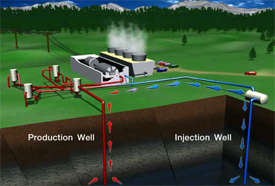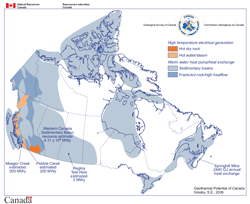Geothermal: The dark horse of renewable energy
 Vancouver, Canada (GLOBE-Net) - Geothermal energy is clean, quiet, virtually inexhaustible and able meet the world’s annual electricity and heating needs many times over with little impact on the climate or the environment. In many jurisdictions, geothermal energy is emerging as a reliable and affordable alternative to fossil fuels. This fourth article in the GLOBE-Net series on renewable energy discusses the dark horse of renewables.
Vancouver, Canada (GLOBE-Net) - Geothermal energy is clean, quiet, virtually inexhaustible and able meet the world’s annual electricity and heating needs many times over with little impact on the climate or the environment. In many jurisdictions, geothermal energy is emerging as a reliable and affordable alternative to fossil fuels. This fourth article in the GLOBE-Net series on renewable energy discusses the dark horse of renewables.What is Geothermal?
Geothermal technology harnesses the energy created by the massive amount of heat at the earth’s core. This vast and renewable energy source can be utilized for either direct heating or cooling of a building or to generate electricity.
Geothermal heating uses heat pumps for efficient water and space heating in buildings and uses the earth as the heat exchanger. Typically hot water stored below the earth’s surface is moved through pipes which transfer heat through the walls and flooring of buildings. In hot months, geothermal heating systems are capable of pumping hot air back into the ground which cools buildings. The technology can be applied to water heating and cooling.
Geothermal technology is more efficient than combustion furnaces for heating or cooling because it only transfers heat from one location to another - as opposed to converting one kind of energy to another. Installation costs are about 50 to 100 per cent higher than that of conventional fossil-fuel-fired furnaces. However it saves homeowners up to 70% heating costs, 75% in maintenance costs and can pay itself back in four years. Solar technology can also be used to power a low energy geothermal heat pump for a completely renewable heating/cooling source.
Geothermal power plants use steam to drive turbines. The steam is naturally generated from water heated deep below the Earth’s surface which is collected then reinserted into the Earth continuously to generate power.
 At current global capacity geothermal power plants supply electricity to about 60 million people, roughly the population of the United Kingdom. These power plants are built where there is access to a geothermal reservoir, which typically occurs along continental plate margins with tectonic activity.
At current global capacity geothermal power plants supply electricity to about 60 million people, roughly the population of the United Kingdom. These power plants are built where there is access to a geothermal reservoir, which typically occurs along continental plate margins with tectonic activity.Most geothermal plants in the world gather the steam from underground pockets of water. The water ranges from 100 to 400 degrees Celsius and remains in a liquid state due to the high pressure environment in which it exists. By drilling into these pockets, the high pressure on the water is relieved and it vaporizes, rising to the surface for geothermal energy use.
Future "hot dry rock" plants may inject water into hot underground areas that lack moisture, producing steam. The equipment used for this form of geothermal drilling is similar to that used for oil wells, but must go much deeper and be wider to accommodate the water cycle.
The Pacific "Ring of Fire", a zone of active volcanoes around the Pacific, provides some of the hottest spots on the planet for geothermal power. More efficient technologies for channeling underground heat are helping extend geothermal power’s reach beyond the "ring of fire".
"When power plant technology in the 1980s was developed to take advantage of lower temperature geothermal resources, the geothermal industry was revolutionized," notes Alyssa Kagel, author of the US Geothermal Energy Association report The State of Geothermal Technology Part II: Surface Technology (part one can be found here). The report discusses new and underused technologies - a few that could revolutionize the industry such as recovery technologies for sought-after minerals in geothermal water and new power plant materials that could resist the wear and tear of time.
New turbines can draw power from underground water that is not hot enough to create high-pressure steam. In July, a 200-kilowatt generator in Alaska started making electricity from water at 74 degrees Celsius, the lowest temperature on record.
"Geothermal is going into a renaissance age," said Doug Heffernan, chief executive of Mighty River Power, one of New Zealand’s largest power retailers. "It’s the only reliable renewable."
Investment Potential
Geothermal energy recently began to draw serious investor attention when the Massachusetts Institute of Technology (MIT) released The Future of Geothermal, a comprehensive study on geothermal resources in North America. The study said if 40% of the heat under the US could be tapped, it would meet demand 56,000 times over. It said an investment of $800 million to $1 billion could produce more than 100 gigawatts of electricity by 2050, equaling the combined output of all nuclear power plants in the US.
Investors can support geothermal power by supporting technology development; investing in existing plants; or by underwriting resource exploration and development. Harnessing geothermal energy involves higher initial investments, sometimes requiring years of drilling to map underground heat sources. Geothermal exploration and development is also risky and timeframes to come on line does not make it an investor friendly sector.
Government risk-sharing, tax exemptions or subsidies could greatly increase the value proposition of geothermal prospects to outside investors. The growing success of geothermal energy in the United States has mostly been attributed to tax credits handed out to the industry
"New federal and state initiatives to promote geothermal energy are paying off," said Karl Gawell, executive director of the US Geothermal Energy Association. "State renewable standards coupled with the federal production tax credit are creating a renaissance in U.S. geothermal power production."
In the later life of a geothermal plant, operations produce excellent income streams. While the plants often require refurbishment, with careful management geothermal reservoirs need not degrade over time, and net margins often exceed 60%. The fuel for geothermal energy is essentially free which not only allows for lower energy bills for consumers, but allows for a quick turnaround on capital investments.
Current projects typically develop over a three year period, which is actually quite quick when compared to typical 5 year lead times for coal plants.
Geothermal Around the World
- The United States has 86 geothermal projects in development that will provide over 3,300 MW of electric power capacity making the U.S. total over 6,300 MW, enough to meet the energy needs of six million homes.
- The town of Unterhaching, Germany, 22,000 will be warmed by hot water piped from geothermal sources beginning in May, 2008.
- In Unterhaching, geothermal energy will be produced from a 3.4-megawatt generator being installed by German electronics giant Siemens.
- Germany may have more than 200 megawatts of geothermal power-generating capacity by 2016, according to government forecasts.
- In New Zealand, a 90-megawatt plant now under construction will cost $194 million and will boost the country’s geothermal capacity by 25 percent, producing more power than all the country’s wind farms combined.
- In Iceland, there are five major geothermal power plants which produce about 26% (2006) of the country’s electricity. In addition, geothermal heating meets the heating and hot water requirements for around 87% of the nation’s housing.
Geothermal Potential in Canada
Canada has been slow to get into the geothermal game and remains the only Pacific Rim country to not make any serious investments in the energy technology. Many industry experts believe Canada is missing a golden opportunity to tap into its vast thermal resources for electricity production, particularly in the west, and virtually all Canadian homes can utilize geothermal heating using new technology for low heat sources.
In Canada, where one quarter of all energy is used for space and water heating and cooling, there are only 30,000 geothermal heating installations that are used for residential, commercial, institutional and industrial applications, but many believe this is not enough.
"We’re so far out of the game," says Alison Thompson, vice-president of the Canadian Geothermal Energy Association (CanGEA), based out of Calgary, who was quoted in an article in the Toronto Star.
Thompson is quoted as noting that existing data suggests that conventional geothermal projects in British Columbia could amount to 3,000 megawatts, but figures the number is likely closer to 6,000 megawatts. Alberta and the Yukon also have tremendous potential, but a lack of data makes it hard to pin down. Vancouver-based Geothermal Power has leases on 15 properties covering roughly 70,000 acres of land it believes could generate 250 MW of power. According to the study released by MIT, potential geothermal sites even exist in Ontario and other parts of eastern Canada. Next year the GEA hopes to put out a white paper that will serve as a starting point for developing provincial and federal geothermal energy policy. This map from the Natural Resources Canada shows the estimated geothermal potential of Canada.
According to the study released by MIT, potential geothermal sites even exist in Ontario and other parts of eastern Canada. Next year the GEA hopes to put out a white paper that will serve as a starting point for developing provincial and federal geothermal energy policy. This map from the Natural Resources Canada shows the estimated geothermal potential of Canada.
CanGEA’s immediate goal is to lobby the federal government to reinstate its geothermal program and start collecting up-to-date data, through the Geological Survey of Canada, on geothermal hotspots and potential across the country.
Thompson firmly believes that Canada, while behind on geothermal, could leapfrog other countries by jumping into the game with the latest technologies. "Much like developing countries don’t have land phone lines and skipped directly to cellular phones," she noted to the Toronto Star.
A report drafted by Alt Energy Stocks, an alternative energy research firm, suggests that geothermal energy can be harnessed as a co-product of oil drilling. Many existing oil wells bring up sizable quantities of water at temperatures sufficient to run small turbines. While the resource at any one oil well is likely to be small, aggregating all the wells in a large oil field could produce significant power at low cost. Canada’s oil industry in Alberta, where geothermal potential happens to be high, may be able to take advantage of this energy source.
"I just think the future is enormous for this," says Thompson.
You can return to the main Market News page, or press the Back button on your browser.

